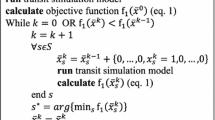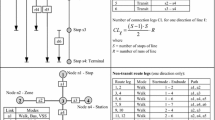Abstract
Transit, although an important public transportation mode, is not thoroughly utilized in the United States. To encourage the public to take transit, agencies have developed systems and tools that assist travelers in accessing and using information. Transit data modeling and trip planner system architecture developments have helped advance these systems, and the recent emergence of transit trip planning algorithms promises further enhancement. Conventional transit trip planning algorithms are usually developed based on graph theory. In order to utilize these algorithms, certain assumptions must be made to support these algorithms (e.g. buses always run on time). However, these assumptions may not be realistic. To overcome these limitations, our study develops an innovative transit trip planning model using chance constrained programming. Unlike previous studies, which only minimized passenger-experienced travel time, our study also considers transit service reliability. Additionally, in-vehicle travel time, transfer time, and walking time are all included as elements of passenger-experienced travel time. Our transit trip planning model avoids the assumptions of previous studies by incorporating transit service reliability and is capable of finding reliable transit paths with minimized passenger-experienced travel time. The algorithm can also suggest a buffer time before departure to ensure on-time arrivals at a given confidence level. General Transit Feed Specification data, collected around Tucson, Arizona, was used to model the transit network using a “node-link” scheme and estimate link-level travel time and travel time reliability. Three groups of experiments were developed to test the performance of the proposed model. The experiment results suggested that the optimal anticipated travel time increased with increasing on-time arrival confidence level and walking was preferred over direct bus transfers that involved out of direction travel. The proposed model can also include additional travel modes and can easily be extended to include intercity trip planning.






Similar content being viewed by others
References
Acer UG, Giaccone P, Hay D, Neglia G, Tarapiah S (2012) Timely data delivery in a realistic bus network. IEEE Trans Veh Technol 61(3):1251–1265. doi:10.1109/TVT.2011.2179072
Brakewood C, Barbeau S, Watkins K (2014) An experiment evaluating the impacts of real-time transit information on bus riders in Tampa, Florida. Transp Res Part A Policy Pract 69:409–422. doi:10.1016/j.tra.2014.09.003
Brakewood C, Macfarlane GS, Watkins KE (2015) The impact of real-time information on bus ridership in New York City. Transp Res Part C Emerg Technol 53:59–75. doi:10.1016/j.trc.2015.01.021
Chandra S, Bharti AK (2013) Speed distribution curves for pedestrians during walking and crossing. Proc Soc Behav Sci 104:660–667. doi:10.1016/j.sbspro.2013.11.160
Chen A, Ji Z (2005) Path finding under uncertainty. J Adv Transp 39(1):19–37. doi:10.1002/atr.5670390104
Chen BY, Lam WHK, Sumalee A, Li Q, Shao H, Fang Z (2013) Finding reliable shortest paths in road networks under uncertainty. Netw Spat Econ 13(2):123–148. doi:10.1007/s11067-012-9175-1
Cherry C, Hickman M, Garg A (2006) Design of a map-based transit itinerary planner. J Public Transp 9(2):45–68
Ferris B, Watkins K, Borning A (2010) Location-aware tools for improving public transit usability. IEEE Pervasive Comput 9(1):13–19. doi:10.1109/MPRV.2009.87
Friedrich M, Hofsaess I, Wekeck S (2001) Timetable-based transit assignment using branch and bound techniques. Transp Res Rec J Transp Res Board 1752(1):100–107. doi:10.3141/1752-14
Fu L, Rilett LR (1998) Expected shortest paths in dynamic and stochastic traffic networks. Transp Res Part B Methodol 32(7):499–516. doi:10.1016/S0191-2615(98)00016-2
Fu Q, Liu R, Hess S (2012) A review on transit assignment modelling approaches to congested networks: a new perspective. Proc Soc Behav Sci 54:1145–1155. doi:10.1016/j.sbspro.2012.09.829
Hershberger J, Maxel M, Sur S (2007) Finding the k shortest simple paths: a new algorithm and its implementation. ACM Trans Algorithms (TALG) 3(4):45–56. doi:10.1145/1290672.1290682
Hoffman W, Pavley R (1959) A method for the solution of the nth best path problem. J ACM 6(4):506–514. doi:10.1145/320998.321004
Huang R, Peng Z-R (2002a) An object-oriented GIS data model for transit trip planning systems. Transp Res Rec J Transp Res Board 1804:205–211. doi:10.3141/1804-27
Huang R, Peng Z-R (2002b) Schedule-based path-finding algorithms for transit trip-planning systems. Transp Res Rec J Transp Res Board 1783:142–148. doi:10.3141/1783-18
Ji Z, Kim YS, Chen A (2011) Multi-objective α-reliable path finding in stochastic networks with correlated link costs: a simulation-based multi-objective genetic algorithm approach (SMOGA). Expert Syst Appl 38(3):1515–1528. doi:10.1016/j.eswa.2010.07.064
Leiserson CCE, Rivest RRL, Stein C, Cormen TH (2009) Introduction to Algorithms, Third edn. Book, vol. 1312. doi:10.2307/2583667
Li F, Wu T, Badiru A, Hu M, Soni S (2013) A single-loop deterministic method for reliability-based design optimization. Eng Optim 45(4):435–458. doi:10.1080/0305215X.2012.685071
Liu L, Yang J, Mu H, Li X, Wu F (2014) Exact algorithms for multi-criteria multi-modal shortest path with transfer delaying and arriving time-window in urban transit network. Appl Math Model 38(9–10):2613–2629. doi:10.1016/j.apm.2013.10.059
Nuzzolo A, Crisalli U (2004) The schedule-based approach in dynamic transit modelling: a general overview. Oper Res Comput Sci Interfaces Ser 28:1–24. doi:10.1007/978-1-4757-6467-3
Olson David L, Wu D (2010) Enterprise risk management models. Springer, Berlin Heidelberg
OneBusAway (2015) Retrieved August 1, 2015, from http://onebusaway.org/
OpenTripPlanner (2016) Retrieved May 1, 2016, from http://www.opentripplanner.org/
Schmöcker JD (2006) Dynamic capacity constrained transit assignment, (September), 202. Retrieved from http://www3.imperial.ac.uk/pls/portallive/docs/1/36049696.PDF
Sun D, Peng Z-R, Shan X, Chen W, Zeng X (2011) Development of web-based transit trip-planning system based on service-oriented architecture. Transp Res Rec J Transp Res Board 2217:87–94. doi:10.3141/2217-11
Wong SC, Tong CO (1998) Estimation of time-dependent origin–destination matrices for transit networks. Transp Res Part B Methodol 32(1):35–48. doi:10.1016/S0191-2615(97)00011-8
Yang S, Malik A, Wu Y (2014) Travel time reliability using Hasofer Lind-Rackwitz Fiessler algorithm and kernel density estimation. Transp Res Rec J Transp Res Board 2442:85–95. doi:10.3141/2442-10
Yang S, Wu Y (2016) Moving ahead to mixture models for fitting freeway travel time distributions and measuring travel time reliability. Transp Res Rec J Transp Res Board. doi:10.3141/2594-13
Yen JY (1971) Finding the K shortest loopless paths in a network. Manag Sci 17(11):712–716. doi:10.1287/mnsc.17.11.712
Acknowledgements
This research was supported by funding from the U.S. Department of Transportation via the National Center for Intermodal Transportation for Economic Competitiveness under contract number DTRT12GUTC14. The authors also thank the Pima County Association Governments (PAG) and the Sun Tran for data support. Thanks go to Mr. Payton E. Cooke for proofreading.
Author information
Authors and Affiliations
Corresponding author
Rights and permissions
About this article
Cite this article
Chen, Y., Yang, S., Hu, M. et al. A reliability-based transit trip planning model under transit network uncertainty. Public Transp 8, 477–496 (2016). https://doi.org/10.1007/s12469-016-0134-y
Accepted:
Published:
Issue Date:
DOI: https://doi.org/10.1007/s12469-016-0134-y




